"The Bryn Athyn Cathedral in Pennsylvania called me about a stack of leftover Brazilian rosewood that would have been a living tree in the 1700s": How Santa Cruz's Richard Hoover sources antique materials for his luxurious lutherie
Santa Cruz captain Richard Hoover applied his ultimate artistic expression to his historic Vault Series that made its stunning debut at NAMM 2024 last week.
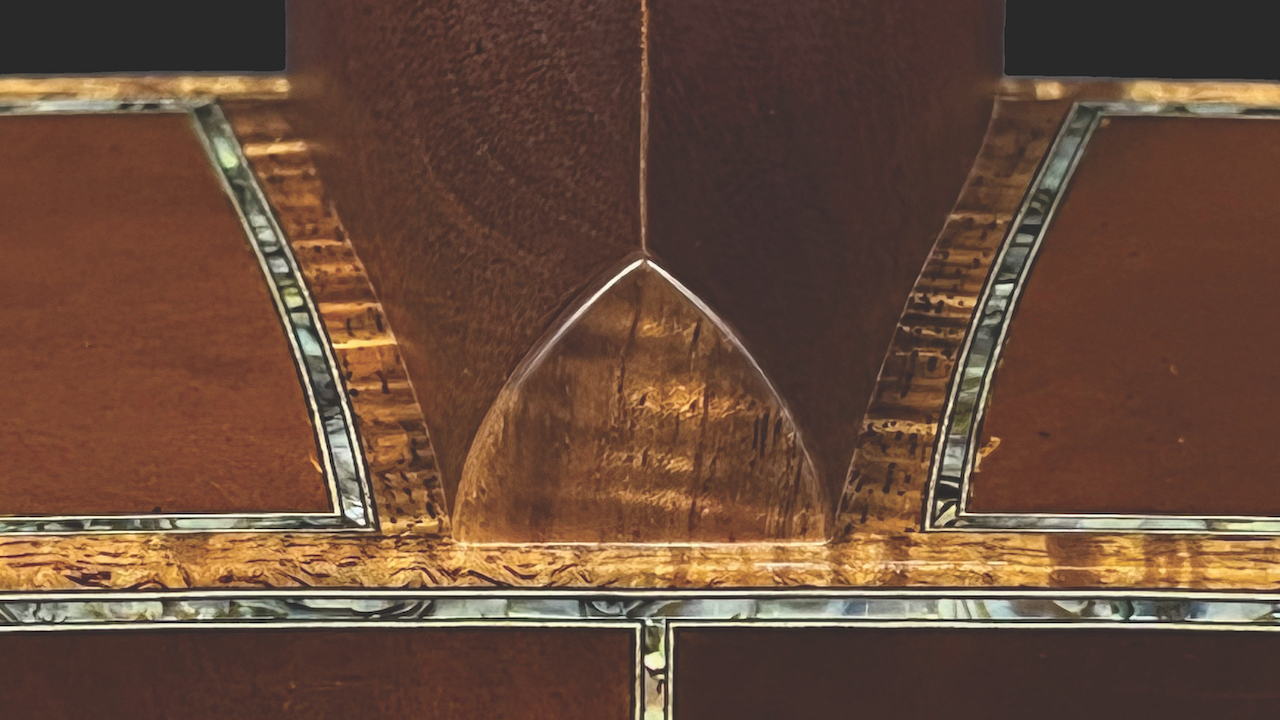
"These four guitars represent a lot,” Richard Hoover explains. “Everything that has happened to me, everything I believe in, the people with whom I have been associated, et cetera. I want to promote certain concepts, because there is too much bias against them.”
Whether he’s dispelling myths about wood, championing small body styles or epitomizing boutique success without compromising ethics, Hoover is a wellspring of know-how. His top passion topics include acoustic physics, the rich history of how we got to today’s guitars and how to manifest a brighter future with better guitars for everyone.
The captain and his elite crew are leading by example and pouring lifetimes of experience into the Vault Series. “In the beginning, guitars were made out of rosewood, mahogany and maybe maple,” Hoover notes. Since then, he explains, we’ve come to embrace a wide variety of species, from koa to walnut, and Hoover remains a key catalyst for progress.
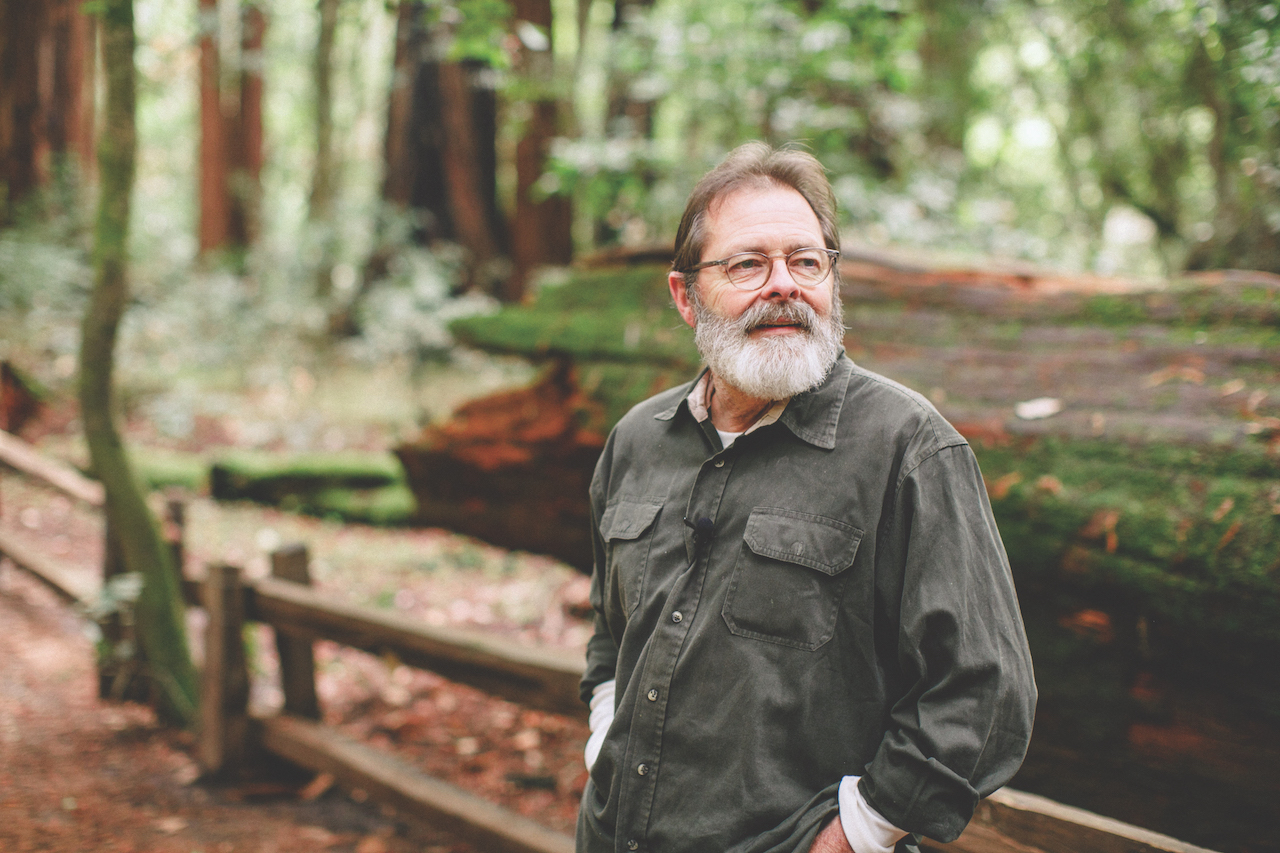
GP listened at length to the bearded guru with the self-described “wood problem” in his most sacred space: the vault where wooden treasure is kept at his headquarters in Santa Cruz, California. Hoover has accumulated a bounty of top-shelf tonewood booty, sustainably resourced via deep-root connections with fellow wood enthusiasts around the globe. Imagine talking to Willie Wonka in the cocoa vault at the chocolate factory. Like a kid in a candy store, Hoover beams over each precious piece, tapping for tone and offering insights about color.
This is not just about making the world's best guitar; this is about allowing the world to make the best guitar
Richard Hoover
However, he understands that he’s in the twilight of a golden career that has significantly raised the guitar bar. It’s time to crack open the vault and put his wooden jewels into crowning achievements. Hoover combines the best woods with ultimate artisanship from the stalwart staff at Santa Cruz Guitars, which is a true custom shop where each instrument is handmade according to orders from dealers and clients. The key difference is that Vault Series instruments are being customized to company specs, representing personal tastes, preferences and beliefs.
It starts at the top, and Hoover is widely recognized as the Stradivari of steel-string guitar lutherie. It’s no coincidence that he draws heavily from the violin-making tradition. As an upstart in America’s bicentennial year, Hoover dreamed of treating every creation as a passion project. He’s living proof that a positive attitude is key to realization. All the words that follow are his own.
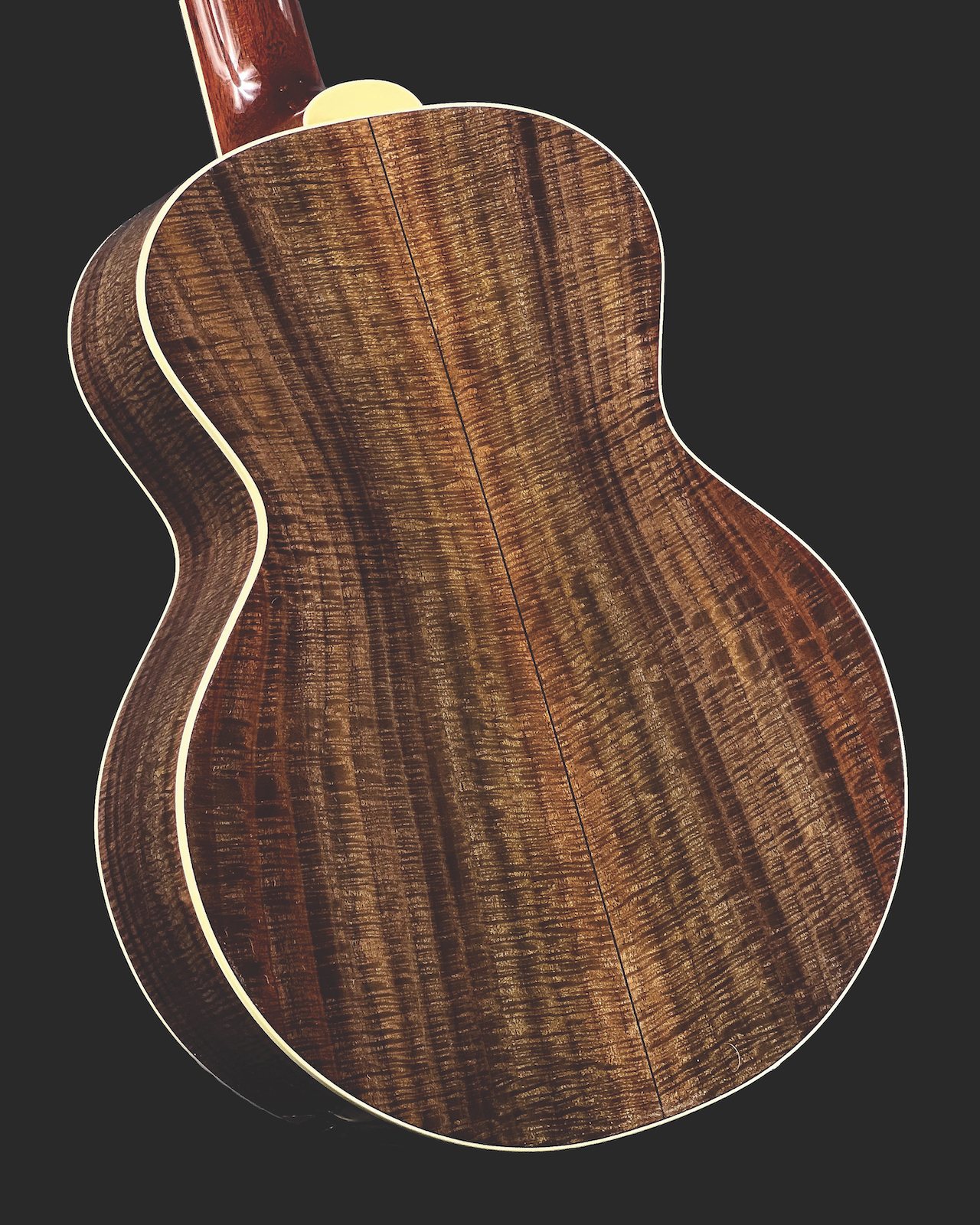
“I no longer have the luxury of looking at a beautiful piece of wood and saying, ‘It’s too nice. I’ll wait until later,’” he says, explaining the Vault Series. “I didn’t want to just cash ’em in, and I didn’t want to just use it without applying the power of the principles instilled in me by my mentors, which is that you can become successful by doing the right thing. So the idea of using some precious wood in this series is a way for someone to support that cause going forward and have a piece as a testimony to being part of our success in that regard. Vault guitars represent not only the best of the best but also the culmination of decades of trust. The idea is to capture that while I still can and allow people to get in on it. Each wood has a beautiful back story.
All the latest guitar news, interviews, lessons, reviews, deals and more, direct to your inbox!
“The Bryn Athyn Cathedral in Pennsylvania was built around 1913 to 1919. They called me about a stack of leftover Brazilian rosewood that would have been a living tree, possibly in the 1700s. It’s like finding a Stradivarius in the attic. Interestingly, Brazilian rosewood must go through a process after it stops living to get the beautiful color and so forth. When wood is in a board that long, it will oxidize. When you see Brazilian with that beautiful black inky stripe, sometimes spider web-y, it’s part of that process.
If you leave it long enough, it’ll all turn black. This is advanced, so it’s got a lot more black, which is kind of spooky. But within that are subtle little golden flames, and some sections have a bright golden part. It’s a profound story of a beautiful, well-traveled wood that fell into our hands. So what do you do with that? Charge an extra hundred bucks for it? I don’t think so. What is right is to put it into a project like this, where the different components of the story amplify each other and you end up with an object that represents way more than the value of the sum of its parts. This wood is like once in a lifetime for me, and this is the perfect place to put it.”.
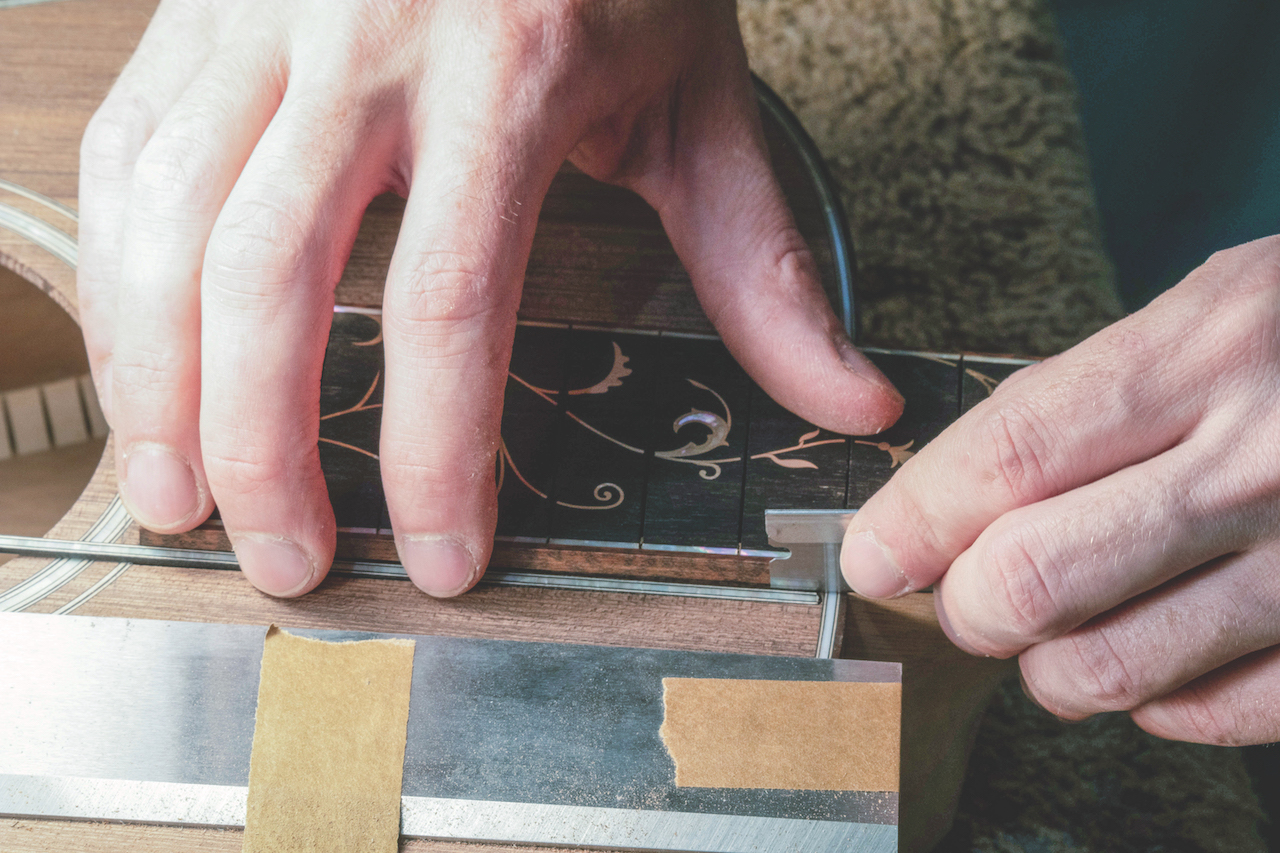

The D 7882: an artisanal custom dreadnought
“We chose to make the top out of redwood from Fort Ross Chapel. Russians coming through Alaska built it around 1820 in Northern California as their southern outpost. Judging by the growth rings, we can determine that this wood is a couple of millennia old. Old woods are cool. They sound better, they look better, they have more stability, and you’re doing a better thing by using responsibly harvested tonewoods.
“Brazilian rosewood is easy to explain. It’s going to add clarity, so you’ll hear the notes clearly and separately, with a lot of nuances. It’s great for a pro player who wants to showcase their style and technical proficiency. Redwood is one of more difficult tonewoods to put into words, but it has a bright, clear sound too. The common misconception is that it’s close to pine, which it isn’t.
Old woods are cool. They sound better, they look better, they have more stability
"Redwood is close to cedar and its properties of sound. But redwood is astounding. Within the structural physics of the guitar, redwood is superb. The other misconception about redwood is that it has a short tonal life and that you can overdrive it if you play hard. Those are myths based on the association with cedar, and they are not true in either case.
“Ultimately, this is going to be a very articulate dreadnought. Let’s make a bluegrass analogy: In the old days, the dreadnought was the drums. It was a rhythm machine, and for that a warmer tone would be desirable. The first guitar we built for Tony Rice was a dreadnought with a cedar top, because I knew it would nail the older sound he was after.
"But today, with players using the dreadnought for leads that were formerly played by the violin or mandolin, more articulation is desirable, and this guitar will be perfect for that contemporary dreadnought sound. The fact that both woods on this guitar came from chapels is a nice connection. I like to think of these guitars representing a whole lineage and history of people living and dying for causes or faiths and so on. It’s a big deal to be a shepherd of that material, and then to pass it on to somebody else that truly feels the full weight.”

The H13 1854: a back story with an ancient history
“These back and sides are made of ancient kauri, which comes from New Zealand and is huge, like our sequoia. When a natural mega-disaster hit ancient New Zealand, this kauri forest was buried instantly, without any oxygen, meaning it wouldn’t oxidize and decay. So, it’s preserved, almost as if it were frozen. It took 45,000 years to ooze its way to the surface.
"Ancient kauri is so unique that there isn’t a true comparison to a familiar wood. I’m not even sure that it’s still wood after 45,000 years. I know it’s not petrified or fossilized. It’s very hard to bend. I’m confident of its structural stability because there are kauri instruments dating back millennia. “One might not assume it would make a great-sounding guitar, but it does. It’s akin to a warmer-sounding mahogany.
This gorgeous redwood was probably approaching 1,500 to 2,000 years old as a tree in our local area. I can tap on it and hear the exact tone that will resonate as an H13 guitar top.
"The H13 is my favorite Santa Cruz body style of them all because it’s the most versatile. The EQ is more even, so it sounds credible playing practically anything. The H13 is the guitar any player can get the most overall value out of on the market or in their hands without having to specify all their own custom specs. And the H13 looks so cool. It’s very symmetrical.”
Smoke underwater: 'Deep Purple' San Lorenzo sinker redwood
“This gorgeous redwood was probably approaching 1,500 to 2,000 years old as a tree in our local area. I can tap on it and hear the exact tone that will resonate as an H13 guitar top. It’s bright, clear and glassy. Judging by the decay at the ends of the log, it was probably underwater at least 300 years in the San Lorenzo River before dislodging.
"It’s some of the densest, clearest-sounding stuff I’ve ever come across. The vendor called it ‘deep purple,’ and it is much darker than most redwood because of the mineral content that would have leached in and oxidized over hundreds of years. At the right viewing angle, you can see a crystalline purple sparkling in the grains. That’s very unusual, and it will become much more prominent when finished, as do the cosmetics of any piece of fine old wood. This is going to shine like crazy and have a sense of movement. My source cuts wood like a jeweler cutting stone. There’s good wood, good wood treated well, and then good wood treated with exceptional care to make it perfect. And that’s the idea of going into these guitars.”
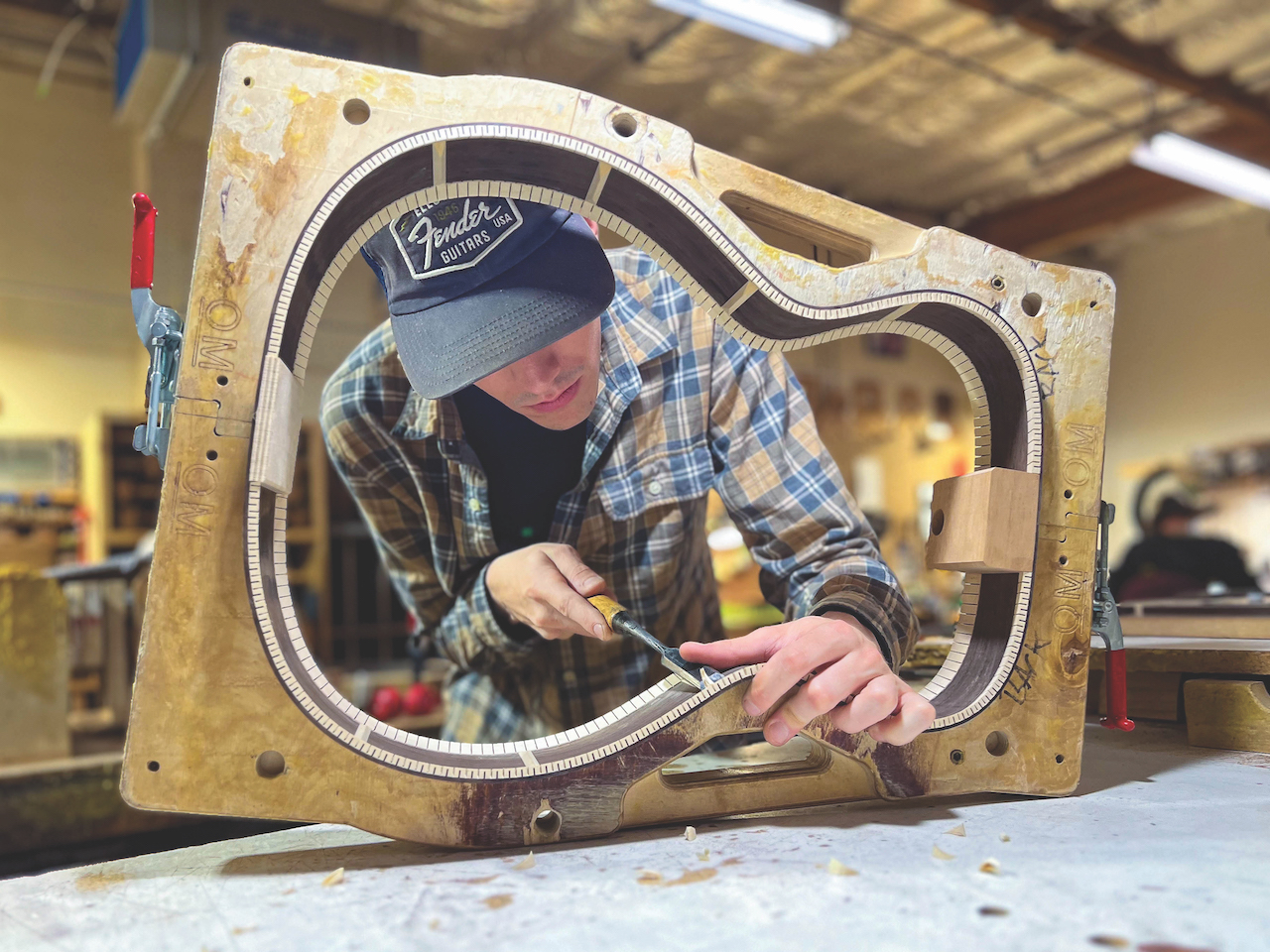
The FF 311: walnut in a nutshell
“I’ve never seen anything like the microflame walnut we’re putting into the FF 311 Custom FireFly. It’s highly unusual and crazy beautiful. It’s almost like it’s dripping. Walnut is a spectacular tonewood. Like koa and mahogany, walnut is as good as any wood you could choose to achieve a particular player’s tone.
"Unfortunately, walnut and mahogany were put into cheaper, less-decorated guitars, and therefore people associated them as lesser, budget woods. But it’s not true. One of my career goals is to promote mahogany and walnut for the spectacular tonewoods that they are, so they get that respect. Like mahogany and koa, walnut populates the middle of the tonal spectrum, from dark to bright. They are my favorites because their versatility allows you to please so many people.
“I’m enmeshed with redwood — the environs, the tree itself and the whole story behind it. I feel the same way about walnut because I grew up with it. Before the interstates, the highways in my part of California were all lined with black walnut trees. When they aged out or fell down, they were used for firewood and fence posts. Occasionally, there would be one with a flare that looked like an old lady’s permanent wave.
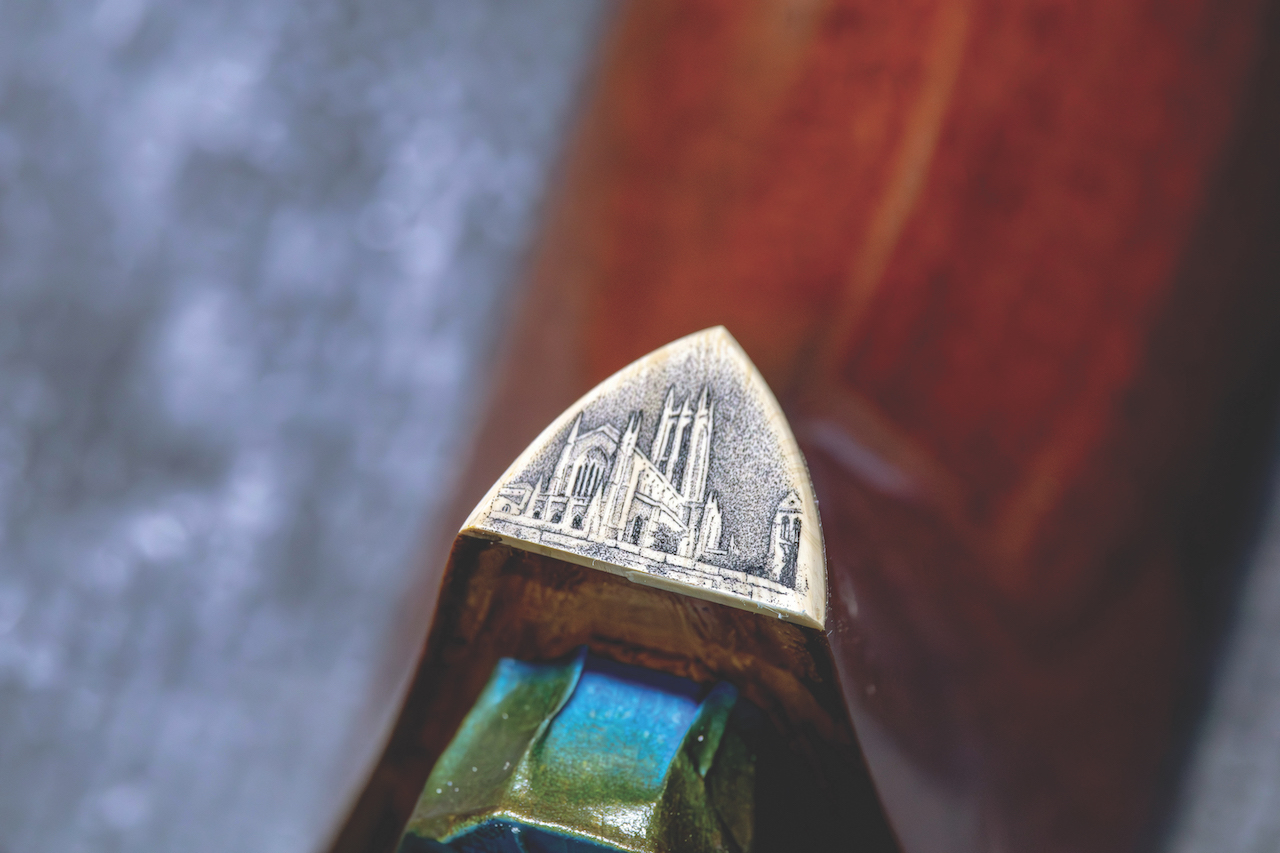
I could get walnut when I was a kid pretty readily. Today, it is so locked in. There really is a walnut mafia that knows where every piece goes, because it’s super-prized for gunstocks, decorative work and things like that. Getting quality wood for a guitar is difficult, and this has a unique flame. So this is a way to present a beautiful piece of walnut that’s highly valued for its tonal potential in a super-expensive guitar for people to appreciate.”
And to top it off… ancient sinker bad cypress?
“Nobody has heard of using cypress on a guitar because it’s nearly extinct. That’s why we’re using reclaimed cypress that’s 1,400 years old. It’s not extremely bright and clear, or particularly warm. It’s kind of in-between, which is great on the tonal scale. And the density is high — it’s extremely stiff. Cypress is a beautiful wood that looks like spruce with more of a chartreuse green sparkle and shine to it, colors you wouldn’t expect in wood.”
The OM 6134: the epitome of a classic
“Everybody can understand an OM made with Brazilian rosewood and Sitka spruce, and here’s one that’ll knock your socks off! We’re not trying to convince anybody of anything, because those woods are already well established as standards for everything good, pure and holy. What we’re showing is that we can make it the best possible through the way we control it.
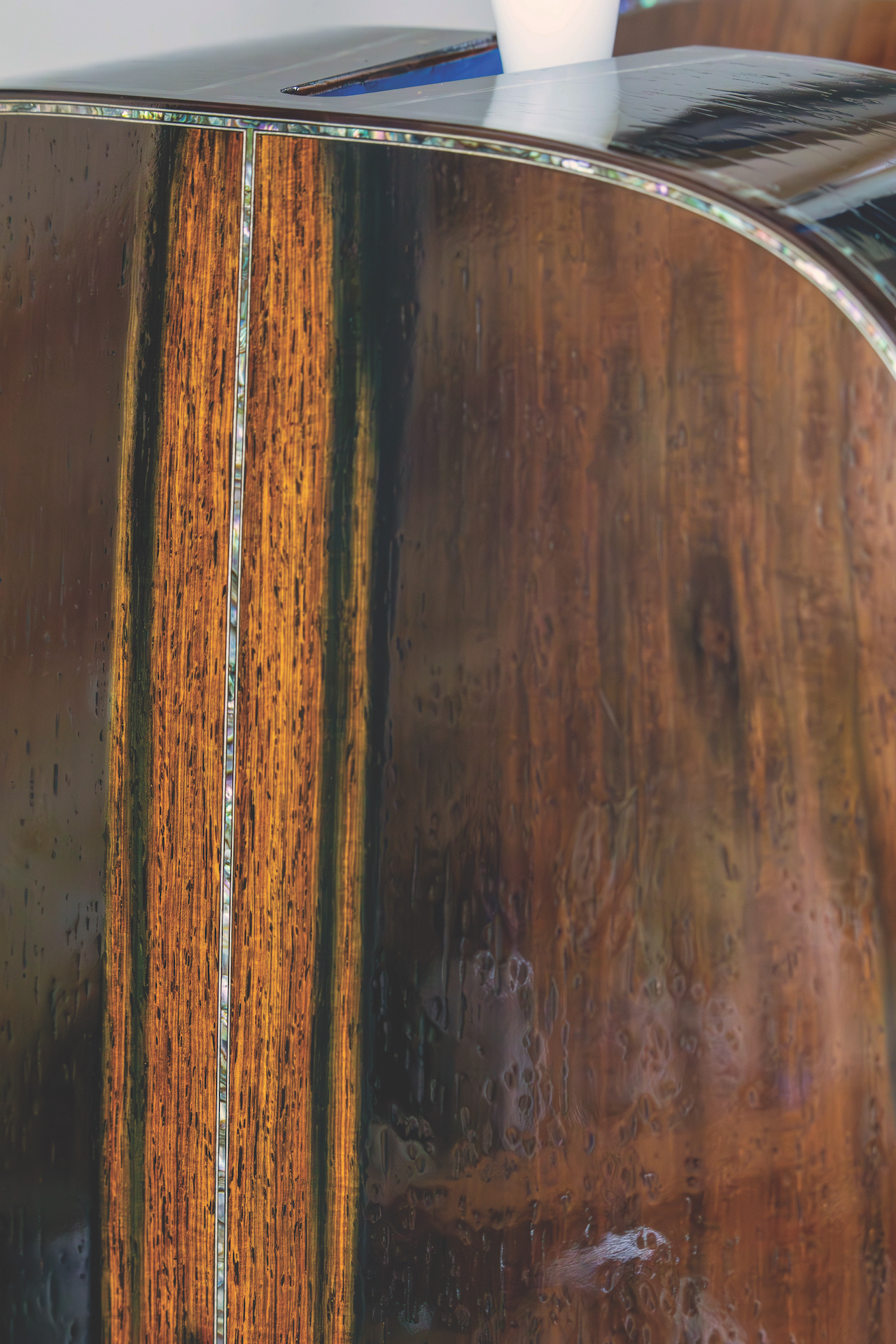
And you can have that too. It doesn’t have to be six figures or whatever. It can be made of Indian rosewood and Sitka spruce and still sound really good because of the quality added in by what we do to the wood. So the OM 6134 is the baseline, the control element among all these experimental-looking things. The other Vault guitars are showcases, like a cheap visual trick to get people to listen to the story about these guitars. They’re all fancy as heck. This one is a known quantity.”
“I’m after this to raise the whole boat of acoustic lutherie. My selfish goal is to be able to train people to make accurate measurements, rather than simply tapping on a piece of wood and saying, ‘Did you hear that?’ The big thing would be if this new measurement system could apply to the cheapest guitars made, accelerating their quality of sound. Can you imagine how many more beginners would stick with a starter guitar that played well and sounded rich with lots of complex overtones and great sustain?
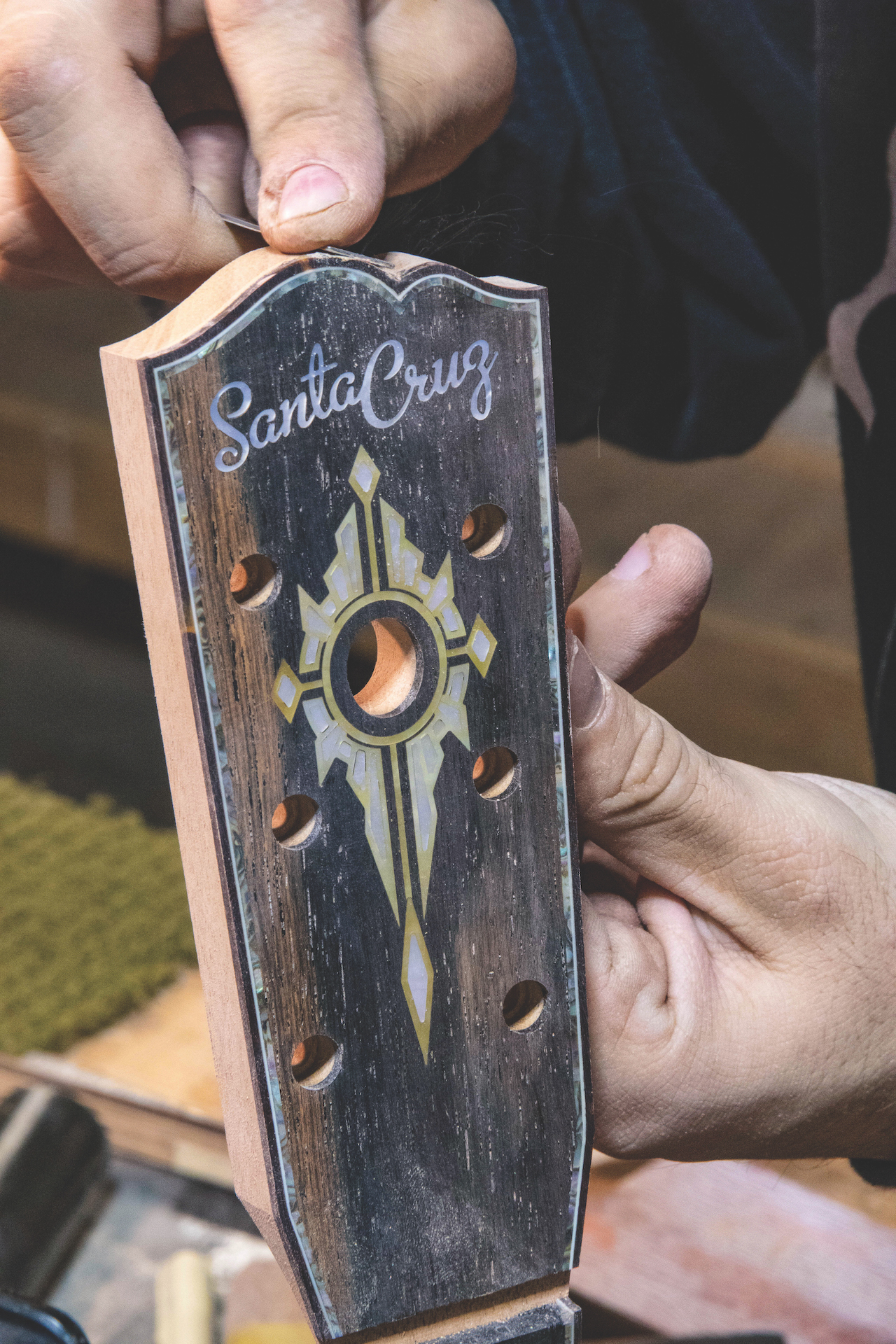
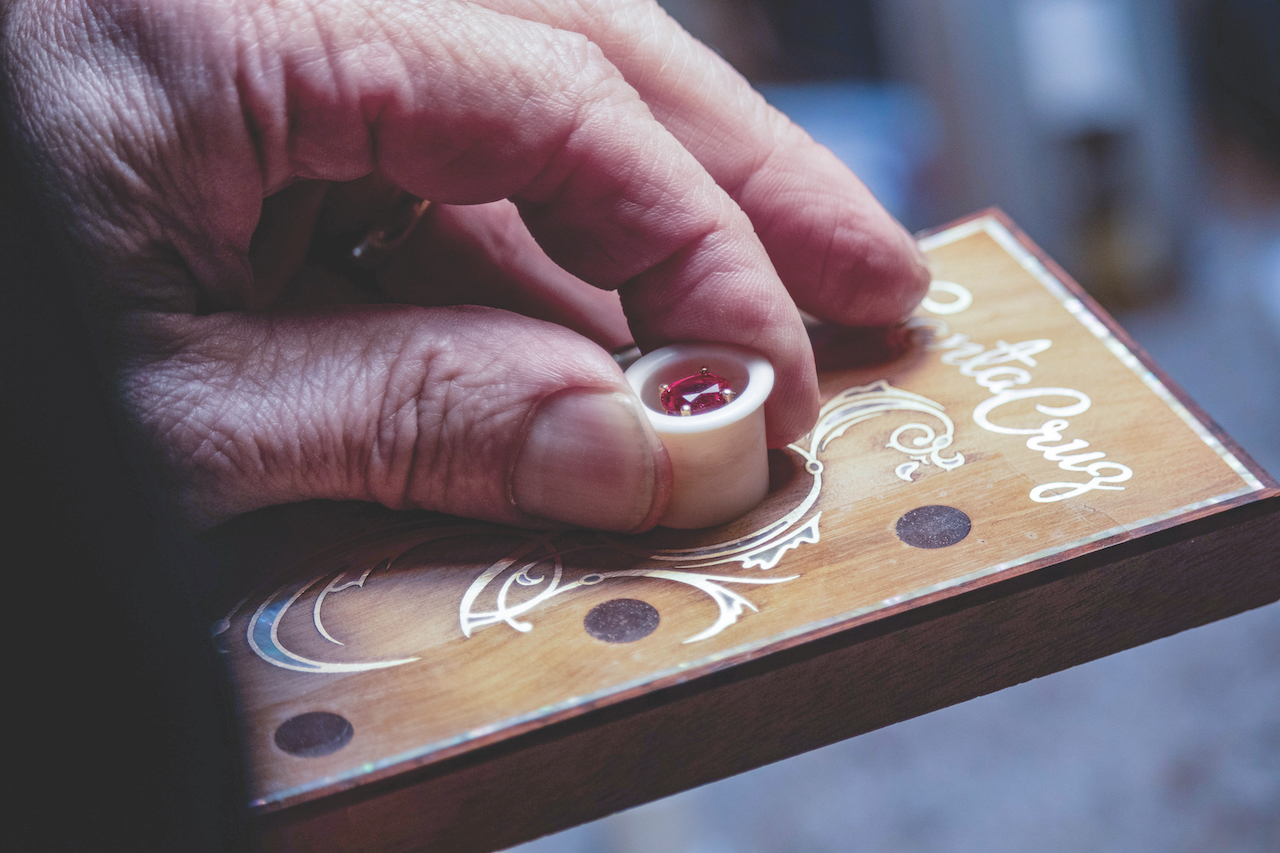
This is not just about making the world’s best guitar; this is about allowing the world to make the best guitar. The goal is to do the research and supply the knowledge so that the starter guitars of the future are like the custom guitars of today, with the quality that will make you bloom as a musician and inspire you to write a song that will change the world.”
“These four guitars showcase what we do, in a dramatic way. We did some things that are just shameless attention-seeking devices, and one came about when we made a custom guitar for a friend: We made a little oval window in the center of the peg head, lined with a faux ivory frame and collar. A gem was suspended with two tiny gold pegs, so it floated in the middle. You didn’t notice it at first, but when you did see it, you jumped out of your seat. It’s not a cheap gimmick — it’s expensive, but it’s not gilding the lily, where you plate a common object in gold. It’s amplifying the importance of this piece, and it makes an onlooker say, ‘This is something important. I’ll look a little deeper.’"
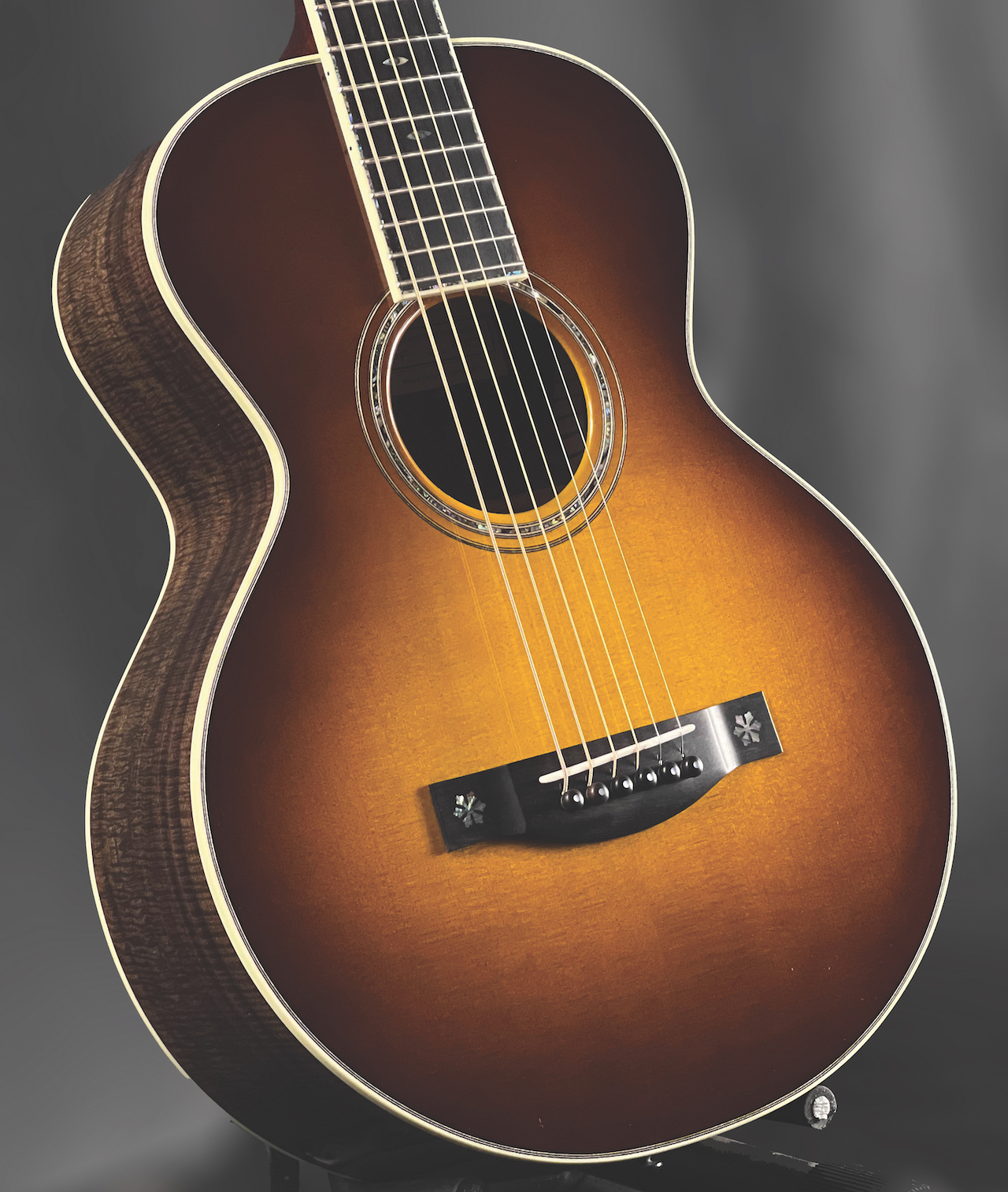
Jimmy Leslie is the former editor of Gig magazine and has more than 20 years of experience writing stories and coordinating GP Presents events for Guitar Player including the past decade acting as Frets acoustic editor. He’s worked with myriad guitar greats spanning generations and styles including Carlos Santana, Jack White, Samantha Fish, Leo Kottke, Tommy Emmanuel, Kaki King and Julian Lage. Jimmy has a side hustle serving as soundtrack sensei at the cruising lifestyle publication Latitudes and Attitudes. See Leslie’s many Guitar Player- and Frets-related videos on his YouTube channel, dig his Allman Brothers tribute at allmondbrothers.com, and check out his acoustic/electric modern classic rock artistry at at spirithustler.com. Visit the hub of his many adventures at jimmyleslie.com
